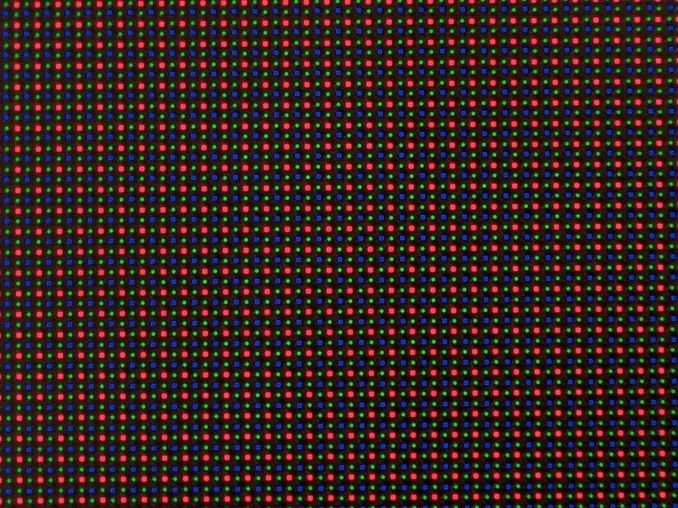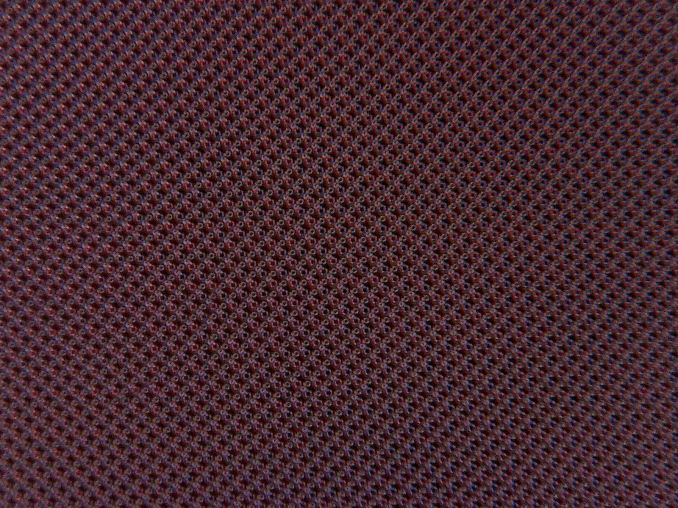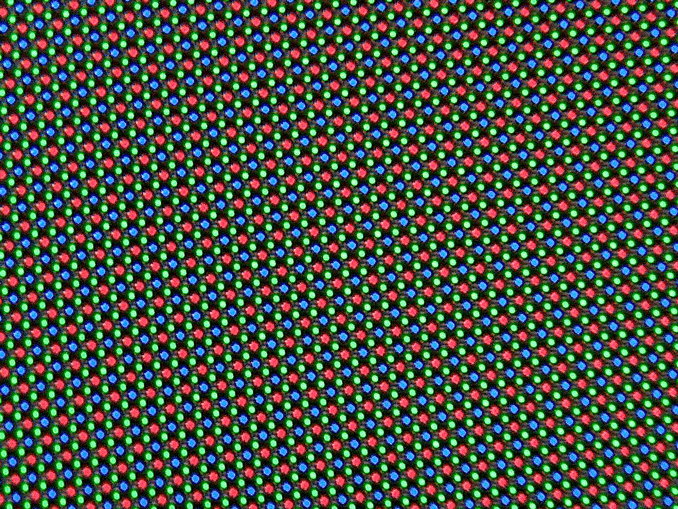A Quick Look at the GS5 LTE-A Subpixel Layout
by Joshua Ho on August 29, 2014 4:47 PM EST
While it was easy to make an educated guess that the Galaxy S5 LTE-A Broadband had a PenTile subpixel layout to support the higher pixel density, I didn't get visual confirmation of this until now. While this picture is rather boring, it's much more interesting to see the display when turned off.
There are a few observations to be made from this photo. While it definitely looks disconcerting and creepy to some, it's possible to make out that there's something set in between the green subpixels when viewed diagonally. This appears to be where the transistors are placed to control a given subpixel. It also seems that the deposition process isn't perfect, as there's noticeable variance in shape and size among subpixels of a given color. This probably explains why the display isn't quite uniform when viewing it at near-black levels. It also appears that there may be an upper bound to how tightly Samsung can place two distinct emitter materials together, as this arrangement has noticeable levels of dead space in between subpixels. In order to better see the full picture, I've included a short gif of the display turning on and off.












21 Comments
View All Comments
edzieba - Saturday, August 30, 2014 - link
If Pentile definied a RGBG 2x2 group as a pixel, that would be fine. But that's not what happens. A single RG or BG pair is defined as a subpixel. Each addressable pixel on a Pentile display CANNOT produce an output in the full gamut.jann5s - Monday, September 1, 2014 - link
an RG or BG pair is defined as a subpixel? or did you mean as a pixel?Rdmkr - Monday, September 1, 2014 - link
It's largely irrelevant because the human eye can pretty much not distinguish color on the detail level of pixels. The "retina" threshold for the ability to tell apart colors lies at a way lower dpi than that for luminatic information. Hence why pentile is almost a battery life, heating and production cost free lunch.jann5s - Monday, September 1, 2014 - link
do you have a reference which details this more, I think this is very interestingRdmkr - Monday, September 1, 2014 - link
I don't have a very good resource on the ready but the wikipedia page http://en.wikipedia.org/wiki/Chroma_subsampling is a good place to start. See also the pictures in http://en.wikipedia.org/wiki/Chrominance and http://en.wikipedia.org/wiki/YCbCr. Pentile exploits the same principle as chroma subsampling.sheh - Friday, August 29, 2014 - link
I hope aperture ratio is going to get more attention. Maybe VR goggles will help with that if they end up becoming common.In distances up to normal desktop usage I find the gridlike-look of LCDs disturbing.
boozed - Saturday, August 30, 2014 - link
The resolution of the "on" photo seems too low to tell whether the variability is truly in the display, or merely aliasing in the photo.JoshHo - Sunday, August 31, 2014 - link
That's true, I'm looking into getting an improved microscope for this purpose. However, the off photo shows it quite well.zepi - Sunday, August 31, 2014 - link
How about taking similar pictures (preferably in scale) of Galaxy Note 3 screen and this one? I'm mostly interested in seeing how things are shaping up from the perspective of Oculus Rift DK1 / DK2 owners, who are interested in seeing how the future is shaped to be.It seems like we will be living our lives trough diamond shaped screen door effect for the next year or two...
jann5s - Monday, September 1, 2014 - link
Can somebody explain to me how this is pentile? I just see a normal RGB bayer mosaic when I look at this photo, i.e. groups of four pixels with 2x green on one diagonal and red and blue on the other diagonal